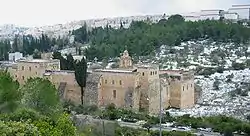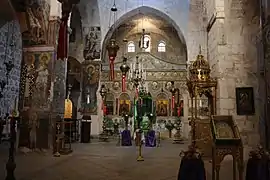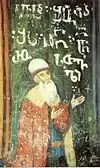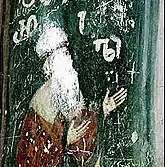Monastery of the Cross
The Monastery of the Cross (Arabic: دير الصليب, Dayr al-Salīb; Hebrew: מנזר המצלבה; Georgian: ჯვრის მონასტერი, jvris monast'eri) is an Eastern Orthodox monastery near the Nayot neighborhood of Jerusalem. It is located in the Valley of the Cross, below the Israel Museum and the Knesset.
| Monastery of the Cross | |
|---|---|
دير الصليب / Deir as-Salib[1] | |
 The monastery in the snow | |
| Religion | |
| Affiliation | Eastern Orthodox Church |
| Location | |
| Location | Jerusalem |
| Palestine grid | 1697/1309 |
| Geographic coordinates | 31°46′19.56″N 35°12′28.8″E |

History
Legend has it that the monastery was erected on the burial spot of Adam's head—though two other locations in Jerusalem also claim this honor—from which grew the tree that gave its wood to the cross on which Christ was crucified.[2]
It is believed that the site was originally consecrated in the fourth century under the instruction of the Roman emperor Constantine the Great, who later gave the site to king Mirian III of Kartli after the conversion of his kingdom to Christianity in 327 AD.[3]
The monastery was built in the eleventh century, during the reign of King Bagrat IV by the Georgian Giorgi-Prokhore of Shavsheti.[3]
Under Sultan Baibars (1260-77) the monks were executed after being accused of being spies for the Ilkhanate Mongols, who had recentyly destroyed Baghdad. In 1305, an ambassador of the King of Georgia, supported by Andronikos II, to Sultan An-Nasir Muhammad ibn Qalawun achieved repossession of the monastery.[4][5]
In the early 1480s Felix Fabri described it: "...we came to fair church, adjoining which is a small monastery, wherein dwell Georgian monks with their wives. When we entered into the church, we were led up to the high altar, which is said to stand on the very spot where grew the tree of the holy cross."[6]
Ottoman era
In the early 1600s, Franciscus Quaresmius described it as: "beautiful and spacious, paved with mosaic work and embellished with various Greek pictures. Moreover, the monastery is now indeed large, fortified and commodious; but formerly it was much larger, as its ruins demonstrate."[7]
Due to heavy debt the monastery was sold by the Georgians to the Greek Orthodox Patriarch Dositheos II in 1685.[8][9] It is currently occupied by monks of the Greek Orthodox Patriarchate of Jerusalem.
In 1697 Henry Maundrell noted: “a Convent of the Greeks, taking its name from the holy Cross. This convent is very neat in its structure, and in its situation delightful. But that which most deserves to be noted in it, is the reason for its name, and foundation. It is because here is the Earth, that nourished the Root, that bore the Tree, that yielded the Timber that made the Cross. Under the high Altar you are shown a hole in the ground where the stump of the Tree stood, [..] After our return, we were invited into the Convent, to have our feet washed. A ceremony performed to each Pilgrim by the Father Guardian himself. The whole society stands round singing some Latin Hymns, and when he has done, every Fryar comes in order, and kisses the feet of the Pilgrim: all this was performed with great order, and solemnity”.[10]
The remains of the crusader-period monastery forms a small part of the current complex, most of which has undergone restoration and rebuilding. The crusader section houses a church, including a grotto where a window into the ground below allows viewing of the spot where the tree from which the cross was (reputedly) fashioned grew. Remains from the 4th century are sparse, the most important of which is a fragment of a mosaic. The main complex houses living quarters as well as a museum and gift shop. The monastery library houses many Georgian manuscripts.
Modern Era


In June 2004, shortly before a visit by the Georgian President Mikhail Saakashvili to Israel, a fresco of the legendary Georgian poet Shota Rustaveli on a column inside the church was defaced by unknown individuals. It is the only extant medieval portrait of Rustaveli. The face and part of the accompanying inscription were scratched out. Georgia officially complained to Israel after the incident.[11][12] The fresco has been restored by Israeli specialists, based on good existing documentation. Similar incidents occurred in the monastery in the 1970s and 1980s. The Georgian inscriptions were painted over and replaced by Greek ones. In a 1901 photograph of the Council of Archangels fresco there are Georgian inscriptions, but 1960 photographs show the inscriptions had been changed to Greek; after cleaning the paintings the Georgian inscriptions emerged again. The same happened in the case of the Christ Anapeson, the "reclining Jesus".[13] In many places (e.g. near the figures of St. Luke and St. Prochore) the outline of Georgian letters are clearly visible under the recently added Greek inscriptions.
See also
References
- Palmer, 1881, pp. 293, 315
- Sylvester Saller & Bellarmino Bagatti, "The Sanctity and Cult of Lot" Archived 2015-09-23 at the Wayback Machine, first published in The Town of Nebo (Khirbet el-Mekhayyat). With a Brief Survey of Other Ancient Christian Monuments in Transjordan, Jerusalem 1949, 5.193–199. Accessed 2008-03-02
- The Wellspring of Georgian Historiography: The Early Medieval Historical Chronicle The Conversion of Katli and The Life of St. Nino, Constantine B. Lerner, England: Bennett and Bloom, London, 2004, p. 35
- Moudjir ed-dyn, 1876, pp. 173-174
- Pringle, 1998, p. 34
- Fabri, 1893, pp. 1-2
- Quaresmius, 1639, vol 2, p. 712. As translated in Pringle, 1998, p. 35
- Pringle, 1998, p. 35
- Georgia's new ambassador to Israel bears a heavy cross, Haaretz
- Maundrell, 1703, pp. 92-93
- Precious Jerusalem fresco defaced, 5 July, 2004, BBC
- Lily Galili, "Defaced Fresco of Georgian Hero Clouds Diplomatic Ties", Haaretz – 05/07/2004.
- Alexander P. Kazhdan (editor) (1991). "Christ Anapeson". The Oxford Dictionary of Byzantium. Oxford University Press. Retrieved 2014-11-21.
Christ Anapeson (ἀναπεσών, lit. “the reclining one”), the image of Christ asleep, awaiting resurrection.
CS1 maint: extra text: authors list (link)
Bibliography
- Clermont-Ganneau, C.S. (1899). [ARP] Archaeological Researches in Palestine 1873-1874, translated from the French by J. McFarlane. 1. London: Palestine Exploration Fund. (p. 330)
- Fabri, F. (1893). Felix Fabri (circa 1480–1483 A.D.) vol II, part I. Palestine Pilgrims' Text Society.
- Guérin, V. (1868). Description Géographique Historique et Archéologique de la Palestine (in French). 1: Judee, pt. 1. Paris: L'Imprimerie Nationale. (pp. 77-82)
- Khurtsilava, Besik 2019, On the history of creating the first basilica in the place of the Cross Monastery in Jerusalem "Pro_Georgia", #1,
- Maundrell, H. (1703). A Journey from Aleppo to Jerusalem: At Easter, A. D. 1697. Oxford: Printed at the Theatre.
- Moudjir ed-dyn (1876). Sauvaire (ed.). Histoire de Jérusalem et d'Hébron depuis Abraham jusqu'à la fin du XVe siècle de J.-C. : fragments de la Chronique de Moudjir-ed-dyn.
- Palmer, E. H. (1881). The Survey of Western Palestine: Arabic and English Name Lists Collected During the Survey by Lieutenants Conder and Kitchener, R. E. Transliterated and Explained by E.H. Palmer. Committee of the Palestine Exploration Fund.
- Pococke, R. (1745). A description of the East, and some other countries. 2. London: Printed for the author, by W. Bowyer. (p. 47)
- Pringle, Denys (1998). The Churches of the Crusader Kingdom of Jerusalem: L-Z (exluding Tyre). II. Cambridge University Press. ISBN 0-521-39037-0. (pp. 33- 40)
- Quaresmius, F. (1639). Historica theologica et moralis Terrae Sanctae elucidatio in qua pleraque ad veterem & praesentem eiusdem terrae statum spectantia accuratè explicantur, varij errores refelluntur, veritas fideliter exacteque discutitur ac comprobatur. ... Auctore Fr. Francisco Quaresmio Laudensi, ordinis Minorum theologo, ... Tomus 1. 2.
- Robinson, E.; Smith, E. (1841). Biblical Researches in Palestine, Mount Sinai and Arabia Petraea: A Journal of Travels in the year 1838. 2. Boston: Crocker & Brewster. (pp. 90, 323)
- Robinson, E.; Smith, E. (1841). Biblical Researches in Palestine, Mount Sinai and Arabia Petraea: A Journal of Travels in the year 1838. 3. Boston: Crocker & Brewster. (p. 123)
- Vogüé, de, M. (1860). Les églises de la Terre Sainte.(p. 340)
- Warren, C.; Conder, C.R. (1884). The Survey of Western Palestine: Jerusalem. London: Committee of the Palestine Exploration Fund. (p. 379)
External links
- Monastery of the Cross, biblewalks
- Survey of Western Palestine, Map 17: IAA, Wikimedia commons